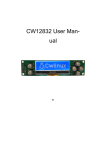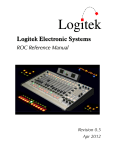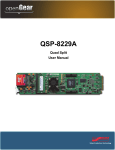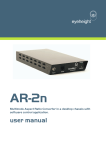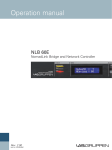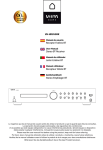Download Ti-2510 - Multi-Input SD Player Block
Transcript
Ti-2510 - Multi-Input SD Player Block Preliminary Information* The Ti-2510 is the latest addition to the award-winning Vieta Ti Line DIN Rail amplifier system and features a full-function SD Player, microphone and line level inputs and GPI control. It can be employed as a stand-alone unit in any audio application however when it is combined with Ti Line amplifier blocks, it provides an all-in-one-place audio solution for a wide variety of installations. The Ti-2510 front-panel controls are duplicated on the IR remote control and further external control possibilities, for example dedicated wall switches, are possible using the 4 General Purpose Inputs (GPI) to trigger programmable snapshots within the Ti-2510. Optionally, the unit can be controlled using Vieta-Net via the Ti-2201 module, Vieta Net Control (VNC) Software and a PC. The Ti-2510 is compact, occupying only a 9U wide space on the DIN Rail, very light-weight and utilises inexpensive, off-the-shelf, 12V DC power supplies (not supplied). SD Player. The SD player in the Ti-2510 features a latest-generation, high-quality MP3 decoder chip which will play both MP3 and WMA (Window Media) files and is suitable for SD cards up to 2 GB capacity. Approximate maximum playing times for MP3 files on a 2GB SD card are as follows: 32 hours playing time (around 500 songs) at “standard” quality - 128 kbps 22 hours playing time (around 325 songs) at 192 kbps** 17 hours playing time (around 500 songs) at 256 kbps** 14 hours playing time (around 500 songs) at highest quality - 320 kbps** Note: Higher quality recordings require the fastest SD cards – so some of the cheaper SD cards are not suitable for this purpose. Front-panel controls are provided for REVERSE, STOP, PLAY, FORWARD, REPEAT PLAY and RANDOM PLAY. There is also a FUNCTION button (F1). Pressing this button accesses the alternative functions for each of these six front-panel controls (alternative functions to be announced). Pressing SAVE, overwrites any previously-saved set-up with the current one. This becomes the new “power-on” default setting and includes all levels, equalisation and source selection. The SD player section is fitted with one red and one green LED indicator. When the red LED is illuminated, STOP has been selected. When the green LED is illuminated the machine is in PLAY. There are separate LED-indicated source selection switches labelled SD, MIC and AUX. Pressing MIC mutes all other sources and selects the microphone input and simultaneously loads any previously-saved, onboard equalisation for this input. The microphone input is optimised for professional level, balanced line, high-impedance dynamic microphones, or condenser microphones requiring 15V phantom power. Pressing AUX mutes all other sources and selects the auxiliary input, an unbalanced, -10 dBV input suitable for the connection of variety of consumer and industrial audio sources – such as the output of a computer soundcard or external music player. Any on-board equalisation specifically applied to the auxiliary input is simultaneously selected. Pressing SD mutes all other sources and selects the output of the in-built SD Player along with any on-board equalisation applied to this source. There are three other front panel switches labelled SEL, “+” (UP) and “-“(DOWN), with an associated 7 segment LED ramp. The SEL switch steps through four functions controlled by the up/down buttons. These are Volume Level, Low Frequency (LF) EQ Level, Mid Frequency (MF) Level and High Frequency (HF) Level. These setting are separately adjustable for each of the input signals and are memorised separately for each input signal when SAVE is pressed. In this way (say) the equalisation for the microphone signal can be optimised without compromising the sound of any other input. To operate the level and EQ adjustment, first select an input source SD, MIC or AUX. The LED will now display the fixed level at which the volume is currently set. Pressing UP will increase this volume, pressing DOWN will reduce it. From this initial status, pressing SEL once will display the LF equaliser setting. If this EQ band is “flat” the central LED will be red and the only one of the 7 illuminated. There are three boost positions; +2dB, +4dB and +6dB and three cut positions; -2dB, -4dB and -6dB, each indicated by one of three upper (boost) or three lower (cut) LEDs. Each time the UP button is pressed the LF equaliser increases by 2 dB, each time the DOWN button is pressed it reduces by 2 dB. Pressing SEL again accesses the MF equaliser setting and pressing the third time accesses the HF equaliser. As each band is selected the centre LED changes colour accordingly – the colour for MF is yellow and for HF is green. The MF and HF are controlled in the same way as the LF. Pressing SEL one more time returns the display to the Volume Level setting for the input source. The method is the same for all three independent inputs. General Purpose Inputs. The Ti-2510 is fitted with four General Purpose Inputs (GPIs). These are opto-isolated relays and the connections are bar-strip connectors labelled 1-4 and with a common ground. The inclusion of this feature greatly expands the flexibility of the Ti-2510 as these inputs can be used to remotely trigger simple or complex changes in the settings of the unit. Default Settings: As delivered, the GPI inputs are set-up with following defaults. GPI 1 – select MIC input GPI 2 – select AUX input GPI 3 – SD PLAY GPI 4 – SD STOP These setting are chosen for the following commonly requested applications: Making Announcements (using GPI 1) Connecting an announcement microphone to the Ti-2510 MIC input and simultaneously connecting the microphone’s pushbutton, on/off switch to GPI 1 allows speech to interrupt any program material. Pressing the “on” button pauses the SD player and changes the source from SD (background music) to MIC (announcer’s voice); if the “on” button is not pressed the Ti-2510 reverts to the SD input and releases PAUSE. Playing Pre-Recorded Messages (using GPI 2) The above concept can be further extended if GPI 2 is connected to a switch that starts a playback machine connected to the AUX input or a switch that simply selects another type of continuous program. This could be a message that needs to be repeated, for example a pre-recorded security message, or it could be an alternative program source, for example the sound from a TV. GPI 3 and GPI 4. As an alternative to using the supplied IR remote, external wall- or panel-mount switches can be connected to these inputs. Custom Settings: The uses of the GPI connections are not limited to the default settings. Different functions can be assigned to these inputs depending on the requirements of the installer. These can be anything from a simple remote version of a switch on the front panel, to triggering a comprehensive snapshot on the Ti-2510 including level changes and EQ settings. This in-depth control is easily programmed by the installer using a PC with VNC software and requires the temporary use of a Ti-2201 Vieta-Net to I/P interface block. Vieta-Net IN/OUT : Vieta Net Address Up to 10 X Ti-2510 Blocks can be controlled for every Ti-2201 Vieta-Net IP Interface Block in the system. The individual Vieta Net address is set on the rotary selector on the Block itself and the output of the Ti-2201 is connected to the Vieta-Net IN Cat5 connector. Multiple Ti Line Blocks – including Ti-2101/Ti-2202 Amplifier Blocks and Ti-2301 GPI/GPO Blocks - are then daisychained using the OUT/IN connectors up to a maximum of 30 for each Ti-2201. The connection points marked TERM are linked when the Block is the last one in the chain. In this way, very large installations can be controlled and monitored – if more than 30 Ti Line Blocks are used, simply add extra Ti-2201 units. In a hotel, for example, this could be one Ti-2201 per floor. Further information on Vieta-Net can be found in the user manual and description of the Ti-2201 Vieta-Net IP Interface Block. Infrared Remote Control The supplied infrared remote control duplicates the front panel controls on the Ti-2510 and has the capacity for extra features (extra features to be announced). The remote-mounting IR sensor connects via a mini-jack input which has an associated THRU to allow multiple units to be controlled from the one hand-set and sensor. Outputs Two, balanced +4dBu outputs are provided on bar-strip connectors for to interface to any professional level audio power amplifier, including the Vieta Pro Ti-2101, 2-channel DIN-rail, amplifier block. Normally the signal at these outputs would be the left and right elements of a stereo signal. Power Supply The Ti-2510 requires a DIN-Rail PSU (not supplied) delivering 12V DC. This is terminated by 2 x screw-type, bar-strip connectors. Dimensions 9U Wide – 157 X 90 X 70 mm (W X H X D) * This document is a description based on the pre-production prototype. Specifications, performance and features may change during product development. If any item described herein is essential to the success of the final installation, please check with Vieta Pro, or one of our authorized distributors, before including the Ti-2510 in your final system design.




